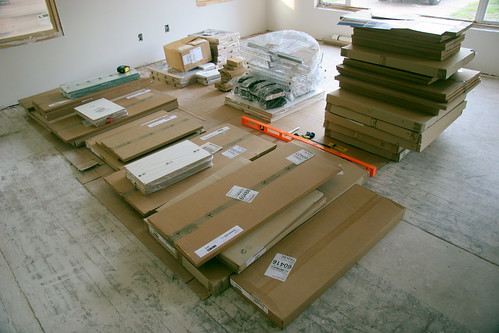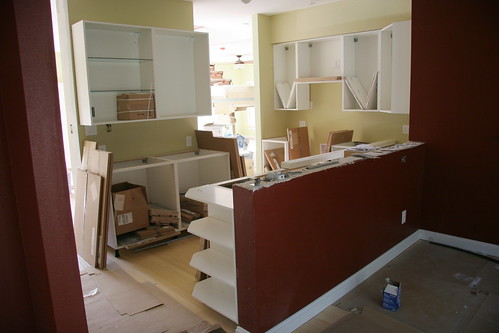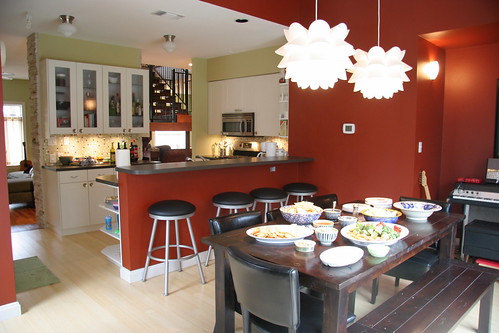
Feng Shui Manhattan Apartment
We look at the front hall and bedroom of a Manhattan apartment that was designed with the ancient Asian art of Feng Shui.
Using the principles of Feng Shui, a designer pays close attention to the flow of energy, or Ch’i, through the rooms of a home or office. Ch'i meaning "flow". A thorough Feng Shui design takes into account everything from the placement of the mirrors to the color of the walls, all with the goal of creating energetic harmony and balance.
This apartment, on Manhattan’s Upper East Side, is owned by Kathleen and John Ullmann, and was designed with the help of R.D. Chin, a leading Feng Shui master based in New York City.
This room offers a good example of how versatile Feng Shui is; you don’t have to have an Asian-looking interior in order for the principles of Feng Shui to go some distance towards creating a home that functions well and makes the inhabitants simply feel good in their environment.
Here is a great, better yet the top website for finding ALL your Oriental & Feng Shui products

Looking at the living room, we see that not only does the room work in terms of Feng Shui, but it also adheres nicely to the Sheffield Guidelines of Interior Design: function, mood, and harmony. The function here is just what one usually looks for in a living room: to provide a public area of the home for entertaining guests, while also allowing for private activities such as reading.
In this living room, the furniture is grouped to allow for comfortable conversation among family members or guests. Two people could snuggle in to the corners of the sofa for an intimate conversation, or guests could spread out among the sofa and chairs to form a few different conversational groups, and everyone would have access to that wide coffee table for drinks and snacks. The oversized corner chair makes an ideal reading nook, with a side table with a lamp that provides good reading light.
One of the functions of this particular living room is to hold the collection of Russian gardener figurines. Before the home was re-decorated, Ullmann says, the figures, mostly white, didn’t show up against the white wall behind them. In fact, one reason Kathleen Ullmann wanted to use Feng Shui in re-doing her home was that the collections in the living room made the room like a museum. “It was dead energetically,” she said.
Now, the collection is lit by the recessed lights, and the bright yellow wall sets off the figurines, making them seem to come to life.
"It has helped my husband to remember the thrill when he started to receive these figurines from his father; he takes pride in the collection being something from his family home in England, and then in being successful enough to buy them on his own,” she said.
The redesign has shown the Ullmanns that the collection is “no longer just about acquisition,” but now can serve as a reminder of their accomplishments and positive life memories. In Feng Shui, each section of a home represents a different aspect of life, and this particular wall represents creativity, so the placement of the collection there encourages the creativity to flow into the home and therefore into the lives of the inhabitants.
“My husband, who is timid and conservative, is proud of the room, and I find he’s more likely to bring guests up and entertain in the living room. The Ch’i, the life, has come back in,” she said.
John Ullmann likes the home’s new look too. “He’s so proud he invites people over to see it,” Kathleen Ullmann said, something he didn’t do so much of before.
The color of the walls in this room was no accident. Ullmann says she elected to use the yellow because she “wanted any wall the sunshine kissed to be yellow,” and she wanted the color of the sky on walls that looked out of the apartment. “I wanted to feel the sense that I wasn’t blocked by walls, but it was an immersion in the sea and sky,” she said.
Because Feng Shui focuses on the movement of energy throughout the rooms, it’s important to consider all the entrances to a given room. This is the reason we’re showing you two slightly different views of this living room. In the first photograph, you’ll note that you can see a doorway to the left, which leads into the bedroom. This portal is open, allowing the energy to move through the living room and then into the bedroom, which is set far back from the entrance to the home, giving a more intimate and private feeling to it.
With the third Guideline, harmony, we evaluate whether everything comes together in the room, and here it does. Achieving harmony in a room’s décor is one of the main goals of Feng Shui, and here we see that the whole room works together. Harmony doesn’t mean that every piece of furniture must match every other piece in terms of period or style or fabric; it just means all the disparate pieces must work together.
In looking at this living room, we can see that the principles of good design and Feng Shui are not far apart from one another: achieving balance and harmony and making sure a room functions well are the goals of any designer’s project. For Kathleen Ullmann, Feng Shui has made what was once “dead space” come to life: “It is absolutely different. Every time I come in, I get happy because I feel that the sun is dancing and kissing my walls and saying Kathleen, look what I did with this wall over here,” she says. “It’s an interaction with the room.”


















 Click play to listen
Click play to listen 


